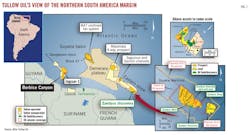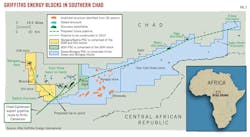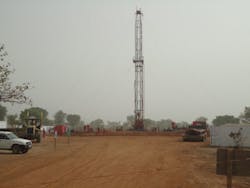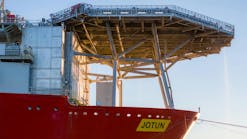Frontier basins around the world are in line for 3D seismic surveys and key exploratory wells as the 2012 midpoint nears.
This article provides capsules on five randomly selected offshore and land exploratory programs in which supermajors and small operators are involved.
Covered here are the Guyana-Suriname basin on the northeastern margin of South America, the Alakol basin in eastern Kazakhstan near the border with China, a new province just east of the Mozambique Channel, an exploration frontier in Nigeria's Niger Delta, and activities in southern Chad basins near the boundary with Central African Republic.
Guyana-Suriname basin
Several companies have taken acreage along South America's northeastern margin where the geology mirrors that of the Tano basin offshore Ghana, where world class deepwater oil discoveries have been made including giant Jubilee field by Kosmos Energy and partners in 2007.
Participants in the area off Guyana, Suriname, and French Guiana include affiliates of ExxonMobil, Shell, Tullow Oil PLC, Statoil ASA, Total SA, Kosmos Energy, Inpex Corp., Murphy Oil Corp., Northern Petroleum PLC, and CGX Energy Inc. (Fig. 1).
A Tullow-led group fanned the flames of this already-hot spot late last year when its Zaedyus wildcat found 72 m of net oil pay in two turbidite fans on the Guyane Maritime block off French Guiana. The well went to 5,711 m in 2,048 m of water 150 km offshore (OGJ Online, Sept. 9, 2011).
Meanwhile off Guyana, CGX Energy said it found water-bearing sandstones with hydrocarbon shows in the Eagle-1 wildcat on its Corentyne license, and a group led by Repsol Exploracion is drilling the Jaguar-1 wildcat on the Georgetown license targeting the Upper Cretaceous.
Tullow and Total shot 3D seismic off French Guiana in late 2009-early 2010, but what is known about the basin comes primarily from 2D data and wells drilled in the 1980s and prior, said Kosmos Energy. More 3D is to be acquired, but the weather window is tight because of stiff currents that flow northwestward from the Amazon River delta.
A drillship is to arrive in June to begin a comprehensive exploratory and appraisal program off French Guiana for the Tullow group. The rig will appraise Zaedyus and explore deeper objectives at the first well, then drill a wildcat.
The Tullow group was to have launched a 3,000 sq km 3D program on Suriname Block 47 in May 2012 and off French Guiana, and in June it plans to shoot the 4,700 sq km Eastern Slope 3D survey and the 620 sq km Cebus 3D survey on either side of the Cingulata fan system containing Zaedyus and other mapped turbidite fans.
The heavy crude in Suriname's coastal Tambaredjo field, producing since the early 1980s, appears to have originated in a deepwater source kitchen. The 16° gravity crude is reservoired at 600-1,300 ft (OGJ, Oct. 12, 2009, p. 36).
Paul Dailly, senior vice-president, exploration, said Kosmos Energy did a year's regional study of the South American continental margin from Brazil to Trinidad in order to understand the regional source rock and reservoir regimes. The company's blocks 42 and 45 off Suriname, southwest of Tullow's Block 47, are in one of the basins that the company high-graded as a result of the regional study.
"The bit that's specific to Suriname is the stratigraphic trapping geometries, and we need the 3D for that," Dailly said.
"This basin has been explored in the past in shallower water and up in the Tertiary and has not had a lot of success to date, but we're looking for stratigraphic trapping geometries buried in the guts of the basin closer to the source rocks…we think that in that position there's a lot of potential for trapping geometries that have been overlooked in the past," he said. "The concept is an extension of the Upper Cretaceous stratigraphic play that we unlocked on the West African side of the margin."
The Tullow group's Zaedyus well has to some extent validated the play concept, Dailly said. The 3D data will also indicate whether the basin harbors features of the size Kosmos Energy is seeking, i.e., a potential of at least several hundred million barrels of light, sweet crude.
Kosmos Energy is contacting seismic contractors now to shoot 3D data this year and might conceivably be in a position to drill as early as 2014.
As it has done off Ghana, Kosmos Energy likely would employ a floating production, storage, and offloading vessel development assuming there were a discovery off Suriname of sufficient size, Dailly said.
Suriname, where the two Kosmos Energy blocks total 2.8 million acres, is the company's first exploratory venture outside West Africa.
The Suriname entry is part of a Kosmos Energy strategy to drill two to four frontier basin-testing wells per year starting in 2013. Besides Suriname, Kosmos Energy has taken positions in Morocco, Mauritania, and Cameroon.
Eastern Kazakhstan frontier
Potential reservoir rocks have been penetrated in Well A-8 in the remote Alakol basin of eastern Kazakhstan in mid-2011 but with no hydrocarbons, and more work is planned.
North Caspian Petroleum Ltd., a subsidiary of International Petroleum Ltd., Perth, intends to shoot 500 sq km of 3D seismic in the second half of 2012 before conducting further drilling.
IPL has 50% interest in the Alakol block, which lies across the border from the multibillion-barrel Junggar-Karamay oil fields in northwestern China.
North Caspian's A-8 well reached a final depth of 2,019 m and was logged and drillstem tested as the company's fourth well on the block. The well tested two zones with reservoir-quality sands on the flanks of Paleozoic-age volcanic intrusions or basement highs.
Oil seeps and sheens prove that the Alakol basin has generated hydrocarbons, and seismic data indicate that potential Jurassic and Triassic reservoirs are present as stratigraphic traps on the flanks of Paleozoic-age volcanic intrusions or basement highs, IPL said.
The large block northeast of Almaty covers parts of the Alakol and Balkhash basins and contains 12 prospects well defined by good quality seismic resolution and pronounced structural features, IPL said. Consulting engineers issued a best estimate of 1.379 billion bbl of undiscovered, recoverable resources on the block.
IPL is operator of the block under a joint operating agreement with Remas Corp. LLP, which owns the other 50% interest.
The A-1 well went to 2,488 m, and testing was postponed. A-2 went to 2,229 m and was suspended in November 2010 due to dangerous winds. A-3 went to 1,066 m and was abandoned in March 2011 after encountering volcanic structures that made it impossible to drill deeper.
IPL said the project area is near Chinese markets and suppliers and benefits from existing infrastructure. The block in Kazakhstan contains a refinery and tank farm, road, rail, and air access, and a crude oil pipeline to China.
Mozambique Channel seismic
South Atlantic Petroleum Ltd., Lagos, in mid-April completed shooting 2D seismic in the Mozambique Channel, including 8,868 km on the Juan de Nova permit and 3,388 km on the Belo Profond block (see map, OGJ, Feb. 2, 2009, p. 40).
The 52,990 sq km Juan de Nova permit in French waters and the 13,770 sq km Belo Profond permit off Madagascar contain a large part of a geologic province east of the Rovuma basin off Mozambique, where Anadarko Petroleum Corp. and Eni SPA have discovered world-class gas resources in Offshore Area 1 and Offshore Area 4, respectively (OGJ, Apr. 20, 2012, pp. 70 and 123).
Sapetro has 75% interest in Juan de Nova and 90% interest in Belo Profond. The permits are in 1,800-3,200 m of water.
Modern seismic data indicate that the blocks contain substantial thicknesses of favorably structured Tertiary and Mesozoic sedimentary packages throughout the acreage resting on a large submerged continental crustal block, Sapetro said.
It calls the entire area effectively a 'paleotransform margin' active from 170 to 90 million years ago. Satellite remote sensing studies have indicated areas of potential hydrocarbon seepage that have been sampled for geochemical analysis as part of Sapetro's exploration program. Sapetro also used the opportunity of the seismic mobilization to conduct geochemical sampling and within 12 months expects to have a portfolio of seismically and geochemically supported prospects for 3D detailing and drilling.
Nigeria's exploration frontier
The Niger Delta is a mature oil and gas producing province, but exploratory drilling in Nigeria has suffered in recent years.
Oil production in Nigeria began in 1958 from Oloibiri field, and since then 1,300 exploratory wells have been drilled, 822 of them onshore, 412 in the shallow offshore, and 82 in deep water, Joe Ejedawe of Ejedawe and Partners Nigeria Ltd., Warri, wrote in the May 2012 issue of the AAPG Explorer.
"Exploration in the Niger Delta has waned over the years, primarily because of difficulties in onshore operations due to community-related disturbances, including militancy and industry unwillingness to invest as a result of perceived poor operational terms," Ejedawe wrote. Of nine play types identified, no more than two or three are penetrated by each well. Ejedawe said technological advances in imaging and drilling overpressured intervals are needed.
Meanwhile, Kingsley Ojoh of Total Upstream Nigeria noted that exploratory drilling in Nigeria peaked in the 1960s and had fallen to abysmal levels in recent years.
Royal Dutch Shell PLC's Nigerian unit estimated that thieves are removing at least 43,000 b/d of oil from the company's pipelines in the Niger Delta.
And ConocoPhillips, the newly upstream independent that recently split from its Phillips 66 refining assets, retained BNP Paribas to help sell its Nigerian assets, Reuters reported. The assets consist of land and offshore oil and gas fields and a share in the Brass liquefied natural gas facility.
Southern Chad discoveries
Subsidiaries of Griffiths Energy International Inc., Calgary, are reentering undeveloped oil discoveries in southern Chad with aspirations of connecting them by two new pipelines to the Chad-Cameroon export system, and the company said it could start producing oil in 2013.
Griffiths Energy submitted to the Chad government on May 11, 2012, a notification of discovery for the Badila-1 well on the 1,419 sq km Mangara/Badila production sharing contract area southwest of Esso Chad's Doba basin producing fields (Fig. 2). Griffiths Energy plans to submit an exploitation authorization application in June 2012 to allow Badila development to start in parallel with the ongoing Mangara field development on the DOB block north of Badila.
On reentry in late April 2012, Badila-1 flowed light, sweet, 31-32° gravity oil at 3,100 b/d on 24-hr test with zero water cut and achieved a maximum rate at the end of the test of 4,025 b/d with wellbore pressure still increasing, the company said. During the test the well recovered 5,050 bbl of crude at a gas-oil ratio of 150-250 scf/bbl.
Based on test data, Griffiths Energy estimated the stabilized flow rate after 3-6 months on electric submersible pump at 7,500-10,000 b/d.
Griffiths Energy said well data indicate Badila-1 to have 123 m of net oil pay in Lower Cretaceous C and D sands, but its mechanical condition allowed access to perforate only 23.5 m in the C sands.
Meanwhile, Mangara field on the 1,446 sq km Mangara block has three wells drilled by previous operators that tested light, sweet oil at unstimulated rates of as much as 1,600 b/d.
Mechanical configuration of Mangara-2 allowed access to perforate only 72 m of net oil pay in the C sands, or less than 20% of the total estimated net oil pay of 82 m in the C sands, 20 m in the D sands, and 280 m in the E sands.
Surface and reservoir samples are to be analyzed for tariff and commercial pricing adjustment agreements required to ship through the export pipeline.
Griffiths Energy has surveyed the route for its planned 120-km Mangara Pipeline that would connect Mangara and Badila fields and future discoveries to the COTCO/TOTCO Chad-Cameroon oil pipeline to Kribi, Cameroon, that has been operating since 2003. Construction is well along on the Mangara Pipeline Logone River crossing.
Despite indications of formation damage, Mangara-2 flowed at a maximum average of 800 b/d of 37° gravity oil, natural, with no water and a 600-1,200 scf/bbl GOR for the final 8 hr of a 24-hr test. Griffiths Energy estimated the well to be capable of 1,500-2,500 b/d on ESP after an acid wash.
The company shot 147.5 sq km of 3D seismic in Mangara field and the nearby Krim exploratory prospect.
Griffiths Energy signed a joint venture agreement with its 25% working interest partner, Soc. des Hydrocarbures du Tchad, on the Mangara exclusive exploitation authorization.
On the Borogop and Doseo blocks totaling 22,414 sq km, Griffiths Energy is studying the optimum commercial development of the Kibea, North Sako, Tega, and Maku discoveries. Kibea, the most distant of the discoveries, lies 225 miles east of the COTCO/TOTCO pipeline.
The studies began in the fourth quarter of 2011 and are scheduled for completion in the second quarter of 2013.
Kibea-1 on the Doseo block has net oil pay in the C, D, and E reservoirs. The E sands alone have 88.4 m of net oil pay identified from logs, of which 75 m were perforated by the previous operator resulting in oil test rates up to 2,200 b/d 33-34° gravity oil.
Based on those results, Griffiths Energy plans to develop Kibea and believes that the recoverable volumes will be of sufficient quantity to anchor the major pipeline required to bring it on production. The same pipeline will provide the infrastructure necessary to develop discoveries made from the extensive exploration inventory of prospects in the Doseo-Borogop concession.
The 824 sq km DOH block has potential for both Upper and Lower Cretaceous sand reservoirs and structural traps. Griffiths Energy is evaluating the block, on which the previous operator drilled and abandoned the N'Donambo-1 exploratory well as a stratigraphic test. Based on Griffiths Energy's interpretation of the logs, that well encountered 21.5 m of net oil pay in the C and D sands and may be reentered.
Griffiths Energy has prepared a ranked list of 30 drill-ready opportunities for systematic execution as a part of the 2013 budget cycle.
More Oil & Gas Journal Current Issue Articles
More Oil & Gas Journal Archives Issue Articles
View Oil and Gas Articles on PennEnergy.com
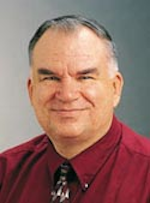
Alan Petzet | Chief Editor Exploration
Alan Petzet is Chief Editor-Exploration of Oil & Gas Journal in Houston. He is editor of the Weekly E&D Newsletter, emailed to OGJ subscribers, and a regular contributor to the OGJ Online subscriber website.
Petzet joined OGJ in 1981 after 13 years in the Tulsa World business-oil department. He was named OGJ Exploration Editor in 1990. A native of Tulsa, he has a BA in journalism from the University of Tulsa.
